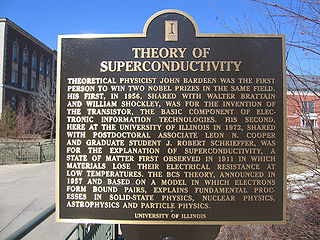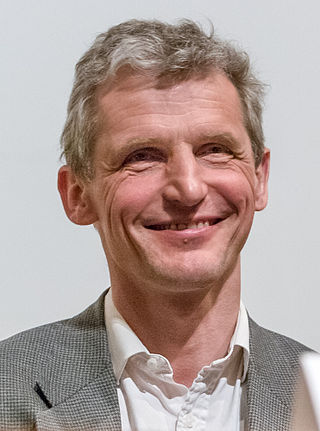Hendricus Theodorus Christiaan (Henk) Stoof | |
|---|---|
| Born | 21 October 1962 (age 60) |
| Nationality | Dutch |
| Alma mater | Eindhoven University |
| Awards | NWO VICI (2003) |
| Scientific career | |
| Fields | Theoretical physics, atomic physics, many-body physics, condensed matter physics |
| Institutions | Utrecht University |
| Doctoral advisor | B.J. Verhaar and W. Glöckle |
Hendricus Theodorus Christiaan "Henk" Stoof (born 1962) is a professor in theoretical physics at Utrecht University in the Netherlands. His main interests are atomic physics, condensed matter physics and many-body physics. He is a Fellow of the American Physical Society.
During the last ten years,[ when? ] the group of H.T.C. Stoof has been involved in the study of various aspects of the physics of ultracold atomic gases. In addition, they performed research on skyrmion lattices in the quantum Hall effect and collective modes in supersolid 4He. Below the results obtained from the study of degenerate Fermi gases are briefly summarized.
Already in 1996 they predicted that an atomic gas of 6Li (a fermionic isotope of lithium) becomes a Bardeen-Cooper-Schrieffer (BCS) superfluid at experimentally obtainable temperatures. They have also performed a detailed study of the superfluid behaviour of this gas below the critical temperature. Motivated by this work, at least six experimental groups from around the world, including the groups of R. Grimm, R.G. Hulet, D.S. Jin, and W. Ketterle, started trying to achieve the necessary conditions for the BCS transition in 6Li. In the last seven years the study of superfluidity in Fermi gases has been at the center of attention of the ultracold atoms community. It is fair to say[ according to whom? ] that the very successful experiments, that ultimately have led to the creation of the superconductor with, as a fraction of the Fermi energy, the highest critical temperature ever, have only been possible due to the use of so-called Feshbach resonances. These resonances were theoretically co-discovered by H.T.C. Stoof in the alkalis in 1993. At that time, the full potential of a Feshbach resonance for studying the crossover from a BCS superconductor of Bose-Einstein condensed Cooper pairs to a Bose-Einstein condensate (BEC) of molecules was not realized yet, but this crossover is now well understood due to the strong connection between experiment and ab initio theory that is possible in this field. The group has made important contributions to the present understanding of how many-body physics affects the BEC-BCS crossover, and how to incorporate the two-body physics of the Feshbach resonance exactly into the many-body theory. Henk Stoof was elected as an APS Fellow for these contributions.
In the last three years,[ when? ] the group of R.G. Hulet at Rice and the group of W. Ketterle at MIT have pioneered the experimental study of spin imbalance on the superfluid state. These experiments have especially concentrated on the strongly interacting or unitarity limit exactly at resonance where the attraction between the atoms is as large as quantum mechanics allows. Again, the group of H.T.C. Stoof made important contributions to this topic. For example, they were first to predict the topology of the universal phase diagram of this unitarity gas, that is now confirmed by the experiments and that contains a tricritical temperature below which the gas phase separates between an (almost) equal density superfluid and a polarized normal gas. Making use of renormalization group techniques, they are up to now the only theoretical group that has been able to accurately calculate this strong-coupling tricritical temperature from first principles. They believe that an important reason for the success in this area of physics is that they have a background in both the microscopic atomic physics and in the macroscopic condensed-matter physics. It is only through a combination of this knowledge that one can arrive at sophisticated many-body theories that can be directly compared with experiment without any fitting parameters.

BCS theory or Bardeen–Cooper–Schrieffer theory is the first microscopic theory of superconductivity since Heike Kamerlingh Onnes's 1911 discovery. The theory describes superconductivity as a microscopic effect caused by a condensation of Cooper pairs. The theory is also used in nuclear physics to describe the pairing interaction between nucleons in an atomic nucleus.

In condensed matter physics, a Bose–Einstein condensate (BEC) is a state of matter that is typically formed when a gas of bosons at very low densities is cooled to temperatures very close to absolute zero. Under such conditions, a large fraction of bosons occupy the lowest quantum state, at which point microscopic quantum mechanical phenomena, particularly wavefunction interference, become apparent macroscopically. A BEC is formed by cooling a gas of extremely low density to ultra-low temperatures.

In condensed matter physics, a supersolid is a spatially ordered material with superfluid properties. In the case of helium-4, it has been conjectured since the 1960s that it might be possible to create a supersolid. Starting from 2017, a definitive proof for the existence of this state was provided by several experiments using atomic Bose–Einstein condensates. The general conditions required for supersolidity to emerge in a certain substance are a topic of ongoing research.

A fermionic condensate or Fermi–Dirac condensate is a superfluid phase formed by fermionic particles at low temperatures. It is closely related to the Bose–Einstein condensate, a superfluid phase formed by bosonic atoms under similar conditions. The earliest recognized fermionic condensate described the state of electrons in a superconductor; the physics of other examples including recent work with fermionic atoms is analogous. The first atomic fermionic condensate was created by a team led by Deborah S. Jin using potassium-40 atoms at the University of Colorado Boulder in 2003.

Deborah Shiu-lan Jin was an American physicist and fellow with the National Institute of Standards and Technology (NIST); Professor Adjunct, Department of Physics at the University of Colorado; and a fellow of the JILA, a NIST joint laboratory with the University of Colorado.

Wolfgang Ketterle is a German physicist and professor of physics at the Massachusetts Institute of Technology (MIT). His research has focused on experiments that trap and cool atoms to temperatures close to absolute zero, and he led one of the first groups to realize Bose–Einstein condensation in these systems in 1995. For this achievement, as well as early fundamental studies of condensates, he was awarded the Nobel Prize in Physics in 2001, together with Eric Allin Cornell and Carl Wieman.
In physics, a Feshbach resonance can occur upon collision of two slow atoms, when they temporarily stick together forming an unstable compound with short lifetime. It is a feature of many-body systems in which a bound state is achieved if the coupling(s) between at least one internal degree of freedom and the reaction coordinates, which lead to dissociation, vanish. The opposite situation, when a bound state is not formed, is a shape resonance. It is named after Herman Feshbach, a physicist at MIT.
A shape resonance is a metastable state in which an electron is trapped due to the shape of a potential barrier. Altunata describes a state as being a shape resonance if, "the internal state of the system remains unchanged upon disintegration of the quasi-bound level." A more general discussion of resonances and their taxonomies in molecular system can be found in the review article by Schulz,; for the discovery of the Fano resonance line-shape and for the Majorana pioneering work in this field by Antonio Bianconi; and for a mathematical review by Combes et al.
Ultracold atoms are atoms that are maintained at temperatures close to 0 kelvin, typically below several tens of microkelvin (µK). At these temperatures the atom's quantum-mechanical properties become important.
Markus Greiner is a German physicist and Professor of Physics at Harvard University.
Superstripes is a generic name for a phase with spatial broken symmetry that favors the onset of superconducting or superfluid quantum order. This scenario emerged in the 1990s when non-homogeneous metallic heterostructures at the atomic limit with a broken spatial symmetry have been found to favor superconductivity. Before a broken spatial symmetry was expected to compete and suppress the superconducting order. The driving mechanism for the amplification of the superconductivity critical temperature in superstripes matter has been proposed to be the shape resonance in the energy gap parameters ∆n that is a type of Fano resonance for coexisting condensates.

Superfluidity is the characteristic property of a fluid with zero viscosity which therefore flows without any loss of kinetic energy. When stirred, a superfluid forms vortices that continue to rotate indefinitely. Superfluidity occurs in two isotopes of helium when they are liquefied by cooling to cryogenic temperatures. It is also a property of various other exotic states of matter theorized to exist in astrophysics, high-energy physics, and theories of quantum gravity. The theory of superfluidity was developed by Soviet theoretical physicists Lev Landau and Isaak Khalatnikov.
Lev Petrovich Pitaevskii was a Russian theoretical physicist, who made contributions to the theory of quantum mechanics, electrodynamics, low-temperature physics, plasma physics, and condensed matter physics. Together with Evgeny Lifshitz and Vladimir Berestetskii, he was also the co-author of a few volumes of the influential Landau–Lifschitz Course of Theoretical Physics series. His academic status was professor.

In the field of cryogenics, helium [He] is utilized for a variety of reasons. The combination of helium’s extremely low molecular weight and weak interatomic reactions yield interesting properties when helium is cooled below its critical temperature of 5.2 K to form a liquid. Even at absolute zero (0K), helium does not condense to form a solid under ambient pressure. In this state, the zero point vibrational energies of helium are comparable to very weak interatomic binding interactions, thus preventing lattice formation and giving helium its fluid characteristics. Within this liquid state, helium has two phases referred to as helium I and helium II. Helium I displays thermodynamic and hydrodynamic properties of classical fluids, along with quantum characteristics. However, below its lambda point of 2.17 K, helium transitions to He II and becomes a quantum superfluid with zero viscosity.
Sandro Stringari is an Italian theoretical physicist, who has contributed to the theory of quantum many-body physics, including atomic nuclei, quantum liquids and ultra-cold atomic Bose and Fermi gases. He has developed in a systematic way the sum rule approach to the collective behavior of interacting systems.
Mohit Randeria is a US-based Indian condensed matter physicist and a professor of physics at Ohio State University. Known for his research on condensed matter theory and superconductivity, Randeria is an elected fellow of the American Physics Society. The Council of Scientific and Industrial Research, the apex agency of the Government of India for scientific research, awarded him the Shanti Swarup Bhatnagar Prize for Science and Technology, one of the highest Indian science awards, for his contributions to physical sciences in 2002. He was awarded the 2002 ICTP Prize of the International Center for Theoretical Physics, Trieste and the 2022 John Bardeen Prize.
Randall Gardner Hulet is an American physicist.
Cindy A. Regal is an American experimental physicist most noted for her work in quantum optics; atomic, molecular, and optical physics (AMO); and cavity optomechanics. Regal is an associate professor in the Department of Physics at the University of Colorado and JILA Fellow; and a Fellow of the American Physical Society (APS).
The I. I. Rabi Prize in Atomic, Molecular, and Optical Physics is given by the American Physical Society to recognize outstanding work by mid-career researchers in the field of atomic, molecular, and optical physics. The award was endowed in 1989 in honor of the physicist I. I. Rabi and has been awarded biannually since 1991.

Gretchen K. Campbell is an American atomic, molecular, and optical physicist associated with the National Institute of Standards and Technology. She works in the field of atomtronics and has received awards in recognition of her research contributions on Bose-Einstein condensates.